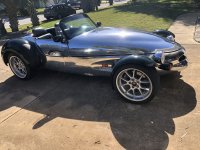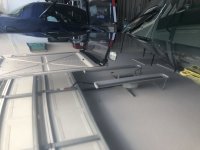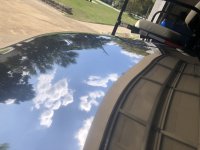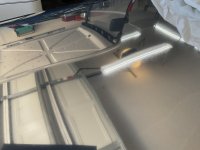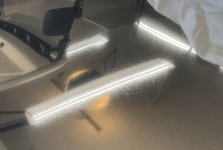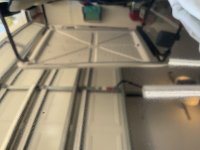Mak
Member
Polished Aluminum advice
First post and looking for some help/advice with the polished aluminum body panels on my Panoz. I’ve been reading through the archives and have found a wealth of good information for my first cut and buff job on another vehicle I recently painted. However, with this bare polished aluminum, I’m still not getting the results I would like to end with.
While it looks far better than it did when I started, there are still a lot of the random orbit swirls or pigtails visible close-up.
There are some scratches so deep I know I will never get them all out, but the very light consistent 3/16” curls will eventually come out with the correct work. Previous owner appears to have hit it with a rotary more than once and scarred the surface with some deeper scratches. I got most out and have brought it back as much as I can with what I’ve tried so far. I had a very difficult time getting photographs that represent what it looks like in-person and up-close.
Looks fantastic from 10’, but up close and at the right angle you can really see the RO scratch pattern. The two up-close photos where you can see the scratches actually look a lot worse than they do in real life. The magnification makes it look worse.
I started with 320 and progressed to 400, 600, 800, 1000, 1200, 1500, 2000 on a random orbit sander with 1/2” soft interface pad. I spent a lot of time with each grit and worked to be careful to remove all the sanding scratches from the previous grit. I even worked in the 800 and 1200 instead of jumping further in hopes of not missing any previous deeper scratches.
I was careful to clean the panel surface and not leave any of the previous grit residue when progressing to the next finer grit. Then I went to a wool pad using the Chemical Guys heavy metal polish. I also tried Mother’s.
I’ve used both my Flex Rotary and also my Flex 3401 RO. I’ve tried Chemical Guys Orange medium and Yellow heavy foam pads. Last thing I tried was a soft foam polishing pad, thinking it would not make any difference but it actually seems to have maybe created even more of the 1/8-3/16” swirls/scratches…
When using the Rotary or RO, I have NOT been applying pressure like in the aluminum diamond-plate polishing video done by Mr Phillips.
I assumed all that pressure was because it was already so oxidized, and I was afraid a lot of pressure would cause even more scratches. Perhaps that is a wrong assumption…
Nothing seems to be making a dent toward reducing those scratches. I suspect I either need to
Thanks
First post and looking for some help/advice with the polished aluminum body panels on my Panoz. I’ve been reading through the archives and have found a wealth of good information for my first cut and buff job on another vehicle I recently painted. However, with this bare polished aluminum, I’m still not getting the results I would like to end with.
While it looks far better than it did when I started, there are still a lot of the random orbit swirls or pigtails visible close-up.
There are some scratches so deep I know I will never get them all out, but the very light consistent 3/16” curls will eventually come out with the correct work. Previous owner appears to have hit it with a rotary more than once and scarred the surface with some deeper scratches. I got most out and have brought it back as much as I can with what I’ve tried so far. I had a very difficult time getting photographs that represent what it looks like in-person and up-close.
Looks fantastic from 10’, but up close and at the right angle you can really see the RO scratch pattern. The two up-close photos where you can see the scratches actually look a lot worse than they do in real life. The magnification makes it look worse.
I started with 320 and progressed to 400, 600, 800, 1000, 1200, 1500, 2000 on a random orbit sander with 1/2” soft interface pad. I spent a lot of time with each grit and worked to be careful to remove all the sanding scratches from the previous grit. I even worked in the 800 and 1200 instead of jumping further in hopes of not missing any previous deeper scratches.
I was careful to clean the panel surface and not leave any of the previous grit residue when progressing to the next finer grit. Then I went to a wool pad using the Chemical Guys heavy metal polish. I also tried Mother’s.
I’ve used both my Flex Rotary and also my Flex 3401 RO. I’ve tried Chemical Guys Orange medium and Yellow heavy foam pads. Last thing I tried was a soft foam polishing pad, thinking it would not make any difference but it actually seems to have maybe created even more of the 1/8-3/16” swirls/scratches…
When using the Rotary or RO, I have NOT been applying pressure like in the aluminum diamond-plate polishing video done by Mr Phillips.
I assumed all that pressure was because it was already so oxidized, and I was afraid a lot of pressure would cause even more scratches. Perhaps that is a wrong assumption…
Nothing seems to be making a dent toward reducing those scratches. I suspect I either need to
- go back to the abrasive papers and work more with a specific range of grits, or
- The polishes I’m using are not the right compound to actually do any meaningful cutting, and I need to be using a different compound, or
- I won’t make any progress with a rotary or RO polisher and need to be using a grinder with one of the buffing wheels and cutting compound bars.
Thanks




